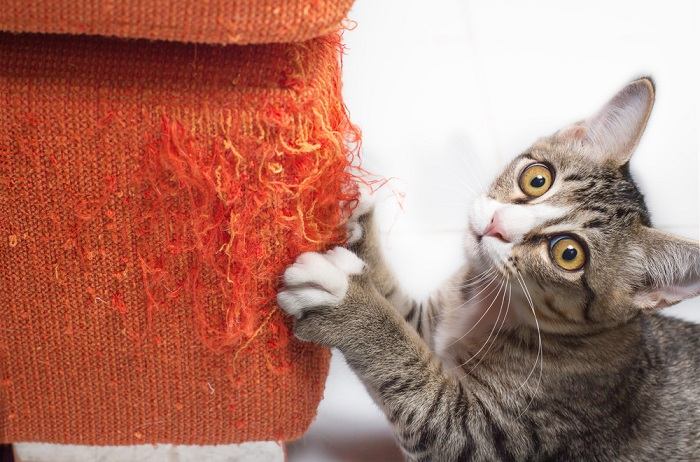We love our feline friends, and we’re sure they love us too … but sometimes our pets’ behavior is not quite what we’d like. Cats are known for their independent spirit and often feisty characters, but that doesn’t mean we have to just abide by their wishes all the time—despite that well-known phrase “dogs have owners, cats have servants!”
Cats are also intelligent creatures, which means they are well able to learn certain commands, and respond to our body language and actions.
Read on for more information about how to keep harmony with your cats while maintaining a respectful pet relationship.
Why Is My Cat Misbehaving?
Behaviors that are natural for cats, like scratching, can be redirected to appropriate places.
Cats perform all sorts of behaviors that we might not understand, but this doesn’t necessarily mean that they are misbehaving. There is a range of “normal” cat behaviors that may overlap with our definition of a “bad cat,” such as aggression, inappropriate toileting, scratching furniture, or excessive vocalization.
Let’s have a closer look at some of these “naughty” traits and see why they might be happening. Finding the cause is often key to being able to change the behavior.
Aggression Toward People
Biting, hissing, scratching, pouncing—all unwelcome behaviors! Why on earth do our cats treat us like this when we feed them, house them, and love them? Cat aggression toward people is a complex issue, but it’s usually related to the following causes: fear or anxiety, frustration, inappropriate play, or illness/pain. A trip to a veterinarian is a usual first step to rule out pain.
Also Read: Food Aggression In Cats: What You Need To Know
Inappropriate play is a common problem. It’s cute and funny to see kittens playing with your toes, but not quite as fun to have an adult cat bite you whenever you go to put socks on! The good news is, if your cat has learned to play aggressively, they can be taught “no,” that this is an unwanted behavior and must stop.
Aggression Toward Other Cats
If you have multiple cats, it can be really stressful to have in-fighting amongst your pets. Cats are territorial, which can make having multiple cats difficult. Ensuring there are enough resources (food, water, litter trays, beds) in different areas that all cats can access their own “space” can help.
Inappropriate Toileting
If your cat goes outside of the litter box repeatedly, it could indicate emotional or physical problems. First assess the cleanlines and location of the box, then consider whether or not your cat may have some health problems contributing to this behavior. Don’t assume that your cat is angry or trying to punish you—this simply isn’t how cats work!
The smell of cat urine is quite unmistakable and entirely unpleasant! Cats may begin to urinate indoors for multiple reasons, including urinary tract disease, stress, territorial disputes, or anxiety. It is important to differentiate between urinating and urine spraying.
Cats usually squat to urinate, and pass a decent volume at a time onto a horizontal surface. Cats spray urine as a form of communication, and this is usually done standing, directed onto a vertical surface, and only a small amount of urine is passed.
Also Read: 8 Tips To Stop A Cat From Spraying
Getting your cat checked by a veterinarian is a good first step to rule out health problems, such as urinary tract infections. Keeping careful note of where your cat is toileting and if anything has changed in your household can be helpful to determine why they have started this problem behavior.
Furniture Scratching
You know you’re in the house of a cat owner when the corners of the furniture are all shredded! Cats love to scratch, and it is an important behavior for them, both to sharpen claws and also as a form of communication as they release pheromones from their pads.
If your cat scratches your carpet, it is possible to train them not to, but you must provide an alternate “safe” place for them to scratch, such as a cat tree or scratching post.
Also Read: How To Stop Cats From Scratching Furniture
Vocalization
Cats that follow you around and meow constantly for attention can be very cute, but excessive meowing can also become tiresome. Some cats want food, some want attention, and some just seem to like the sound of their own voice! Cats can learn boundaries, too, and teaching them the “no” command can give you a break from the incessant noise.
Climbing
Cats are curious creatures, and they love to explore. High places are of special interest, and it is not uncommon to find cats exploring nooks and crannies way above our heads. These behaviors can be dangerous though, so having a cat who will respond to the “no” command can be useful when they look like they might be headed for trouble!
Can Cats Be Trained?
Despite common misconceptions, cats can be trained. The trick is to find out what motivates them.
Most people are familiar with the concept of dog training, but hardly any cat owners attempt to teach their cats. This is mostly due to the reputation of our feline friends for being aloof and highly independent. However, cats are capable of learning basic commands and tricks.
The key points are:
- Patience: It takes time to train animals, so don’t expect a miracle overnight and keep going if you don’t feel you’re getting anywhere.
- Repetition: Cats have the intelligence of an average two-year-old This means they need frequent repetition of a concept before they can understand it.
- Commitment: Training takes time, and needs to be kept consistent. If you tell your cat “no” when they scratch the sofa one day and then don’t bother the next time, they won’t learn.
- An understanding of your cat’s normal behaviors: Knowing why they do what they do helps to make training new habits easier.
How To Teach Your Cat ‘No’
Cats are, of course, not born understanding the word “no.” However, they are highly adapted to reading body language and signals and can understand our tone and intention, even if they do not understand the word itself. Over time, when used consistently, they will then understand that when we say “no,” we are asking for them to cease what they are doing.
Teaching your cat “no” is, in principle, quite simple, but requires a lot of repetition and consistency to make it stick. Try these steps to teach your cat.
- When your cat performs an undesirable behavior, say “no” in a loud firm voice. Stand tall, maintain eye contact and try to use the same voice and posture each time.
- At first, when you say “no,” physically remove your cat from what they are doing, so that they learn to associate the word “no,” with stopping the behavior.
- Re-direct your cat onto a more desirable behavior, such as onto a cat tree if they were scratching the furniture, or give them a toy to play with if they were playing roughly with you.
- Repeat consistently every time they perform the behavior you want to stop.
How To Get Your Cat To Understand ‘No’
Cats don’t understand the word itself, but they are very attuned to tone of voice, body language, and posture. Making sure that you are consistently firm in voice and strong in posture will help your cat understand your meaning. If you feel that the message is not getting across, you can add a hissing noise after the word “no” to emphasize. Do not scare your cat by shouting, screaming, or making big physical actions, as this will only lead to anxiety and frustration.
Also Read: 5 Ways To Build A Stronger Bond With Your Cat
Conclusion
Cats are not as easily trained as dogs, but with consistency and patience, they can learn basic commands such as “no.” If your cat is engaging in unwanted behavior, use the word “no” loudly and firmly whilst removing them from their activity and engaging them in something you would prefer. React consistently to the unwanted behavior in this way and they will soon learn to stop.
Frequently Asked Questions
How do I get my cat to stop doing something?
If your cat is performing a behavior that you want them to stop, say "no" loudly and firmly with a tall, strong posture. Remove them from the activity and move them onto something more preferable. For example, stop them from scratching the furniture and put them on a scratching post.
Why do cats never listen?
It certainly seems that way, doesn’t it? They are listening, they just might not respond how you might like them to. Cats are much more attuned to body language, posture, and expression than they are to spoken language. However, they can be taught basic commands.
Do cats understand when you say no?
Cats don’t understand language, so they will not respond if you just say words to them, including "no." However, they can be taught to understand that saying "no" means you want them to stop what they are doing. By using a loud voice, strong body language, and physically removing them from their activity, they will come to understand through consistent repetition.




















I tried but instead, my cat taught me “yes.”